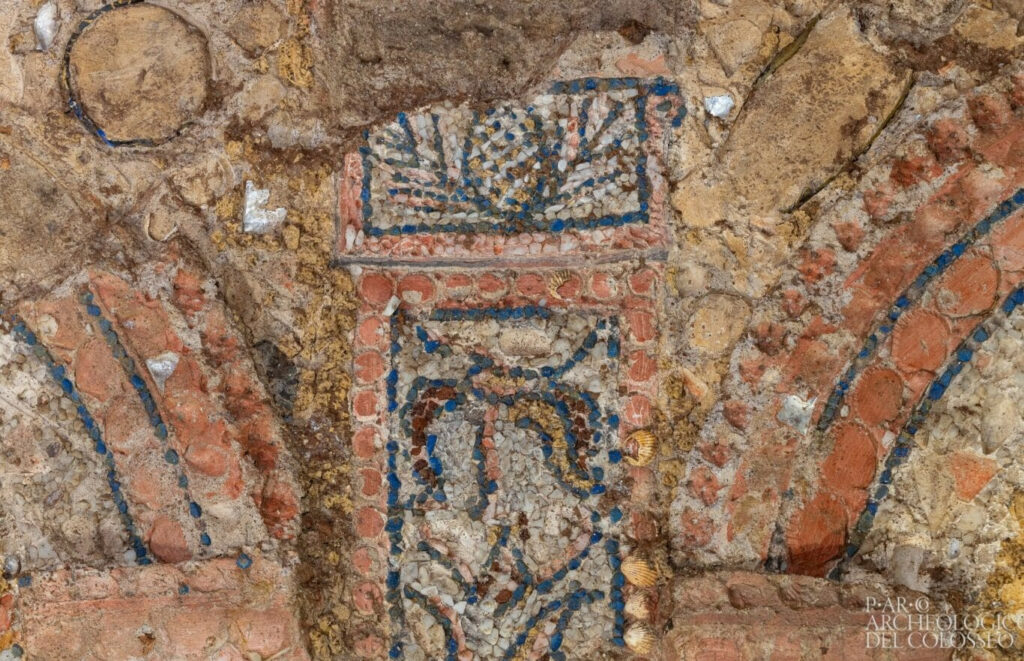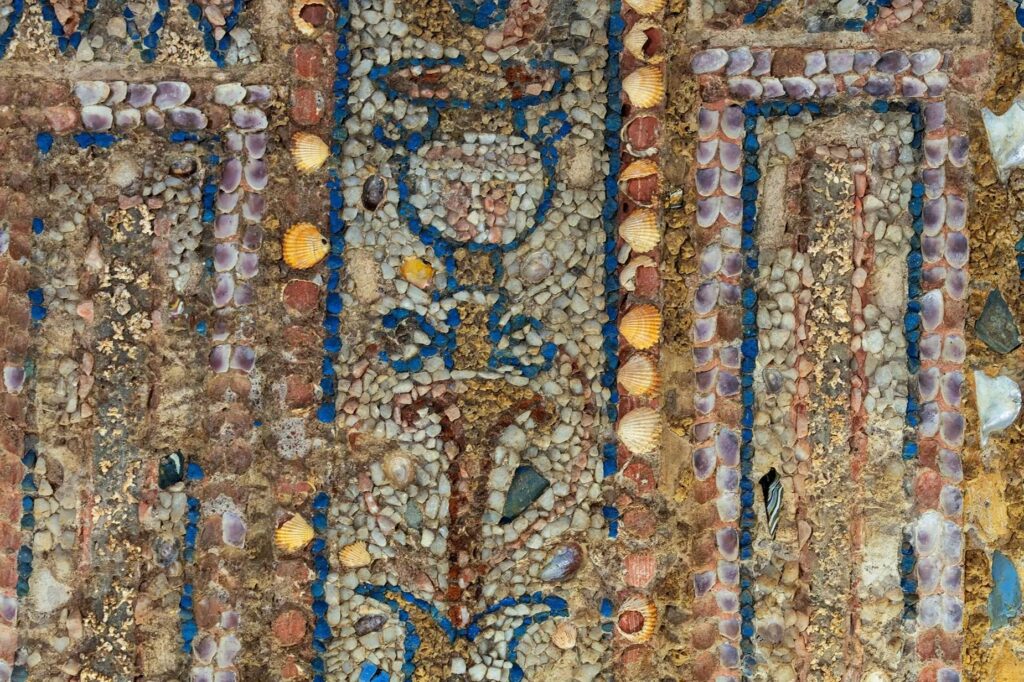In the heart of the Eternal City, an extraordinary archaeological discovery has captivated the world. On the renowned Palatine Hill, a five-year excavation has unearthed a treasure trove that offers a tantalizing glimpse into the opulent lives of ancient Rome’s elite. At the center of this remarkable find is an exquisite, perfectly preserved wall mosaic, estimated to be around 2,300 years old. This ancient masterpiece is not only a testament to the skill and artistry of Roman craftsmen, but also a window into the lavish lifestyles of the city’s aristocracy during the first or second century BC.
The Palatine Hill Mosaic: A Masterpiece Unveiled

Stretching nearly five meters in length, the Palatine Hill mosaic is a breathtaking display of ancient craftsmanship. Its intricate design features a vibrant array of motifs, including vines, lotus leaves, tridents, trumpets, helmets, and mythological sea creatures. What sets this mosaic apart is its unique composition – a dazzling mix of mother of pearl, shells, corals, precious glass shards, and marble flecks. The piece is further enhanced by a frame of polychrome crystals, spongy travertine, and rare Egyptian blue tiles.
The level of detail and the variety of materials used in this mosaic are a testament to the skill and artistry of the ancient Roman craftsmen who created it. The mosaic’s celebratory scenes of naval and land battles suggest that it was commissioned by an extremely wealthy patron, likely a member of Rome’s aristocratic elite. This exquisite work of art not only showcases the technical prowess of its creators but also provides a glimpse into the opulent lifestyles of the city’s most privileged citizens.
Glimpsing the Lives of Ancient Roman Elites

The lavish banquet hall where the mosaic was discovered offers further insights into the lives of Rome’s aristocracy. Measuring 25 square meters, this outdoor dining area overlooking a garden was likely a venue for sumptuous summer gatherings and possibly even water games – a favorite pastime of Roman nobility. The wealth and opulence displayed in the mosaic and other artifacts found on site provide tantalizing clues about the identities and lifestyles of the noble family who once called this property home.
Alfonsina Russo, head of the Colosseum Archaeological Park, notes that the mosaic’s celebratory scenes suggest it was commissioned by an extremely wealthy patron. This lavish banquet hall, with its stunning mosaic and other luxurious furnishings, offers a glimpse into the elite social circles of ancient Rome, where the city’s most privileged citizens gathered to indulge in their love of art, culture, and leisure.
Preserving History’s Fragile Treasures

The remarkable state of preservation of the Palatine Hill mosaic can be attributed to its burial beneath layers of earth on the Palatine Hill. Shielded from the elements for centuries, this delicate artwork has survived intact, offering modern eyes a vivid glimpse into the past. This discovery serves as a powerful reminder of the importance of archaeological preservation and the fragility of historical artifacts.
As excavations continue, researchers are working to uncover more about the noble family who once called this lavish property home. The wealth and opulence displayed in the mosaic and other artifacts found on site provide tantalizing clues about the identities and lifestyles of these ancient Roman elites. By carefully preserving and studying these fragile treasures, archaeologists are able to piece together a more complete understanding of Rome’s rich cultural heritage.
The Enduring Legacy of Rome’s Artistic Achievements

This extraordinary discovery on Palatine Hill serves as a powerful testament to the enduring legacy of Rome’s artistic and cultural achievements. The Palatine Hill mosaic, with its exquisite craftsmanship and opulent design, is a testament to the skill and ingenuity of ancient Roman artisans. As researchers continue to unearth the secrets of this ancient Roman mansion, they offer us an ever-clearer picture of one of history’s most fascinating civilizations.
The preservation of this delicate artwork is a triumph of archaeological perseverance, and it serves as a reminder of the importance of safeguarding our shared cultural heritage. By marveling at the beauty and complexity of the Palatine Hill mosaic, we can gain a deeper appreciation for the artistic and cultural achievements of ancient Rome, and be inspired to continue the work of preserving and studying the fragile treasures of the past.
Conclusion

The discovery of the lavish banquet hall and its stunning mosaic on Palatine Hill is a remarkable achievement in the field of archaeology. This ancient masterpiece not only showcases the technical prowess of its creators but also provides a glimpse into the opulent lifestyles of Rome’s aristocratic elite. As researchers continue to uncover the secrets of this ancient Roman mansion, they offer us an ever-clearer picture of one of history’s most fascinating civilizations.
The preservation of the Palatine Hill mosaic serves as a testament to the enduring legacy of Rome’s artistic and cultural achievements. By marveling at the beauty and complexity of this ancient treasure, we can gain a deeper appreciation for the rich heritage of the Eternal City and be inspired to continue the work of preserving and studying the fragile artifacts of the past. This extraordinary discovery on Palatine Hill is a true testament to the power of archaeology to bridge the gap between past and present, and to unlock the secrets of one of the most captivating civilizations in human history.
